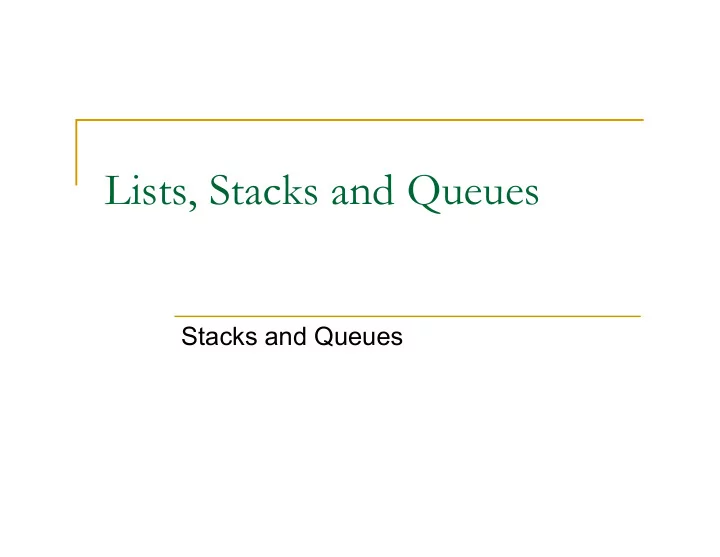

Lists, Stacks and Queues Stacks and Queues
Stacks n A restricted list where insertions and deletions can only be performed at one location, the end of the list (top). n LIFO – Last In First Out q Laundry Basket – last thing you put in is the first thing you remove q Plates – remove from the top of the stack and add to the top of the stack 2
Stack ADT n Basic operations are Stack Model push, pop, and top 3
Adapting Lists to Implement Stacks n Adapter Design Pattern n Allow a client to use a class whose interface is different from the one expected by the client n Do not modify client or class, write adapter class that sits between them n In this case, the List is an adapter for the Stack. The client (user) calls methods of the Stack which in turn calls appropriate List method(s). 4
Adapter Model for Stack Client (Stack user) theStack.push( 10 ) Stack (adapter) theList.add(0, 10 ) ; List (adaptee) 5
Queues n Restricted List q only add to head q only remove from tail n Examples q line waiting for service q jobs waiting to print n Implement as an adapter of List 6
Queue ADT n Basic Operations are enqueue and dequeue 7
Adapter Model for Queue Client (Queue user) theQ.enqueue( 10 ) Queue (adapter) theList.add(theList.size() -1, 10 ) List (adaptee) 8
Circular Queue • Adapter pattern may be impractical • Overhead for creating, deleting nodes • Max size of queue is often known • A circular queue is a fixed size array • Slots in array reused after elements dequeued 9
Circular Queue Data A fixed size array • Control Variables • q arraySize q the fixed size (capacity) of the array q currentSize q the current number of items in the queue q Initialized to 0 q front q the array index from which the next item will be dequeued. q Initialized to 0 q back q the array index last item that was enqueued q Initialized to -1 10
Circular Queue Psuedocode void enqueue( Object x ) { n if currentSize == arraySize, throw exception // Q n is full back = (back + 1) % arraySize; n array[ back ] = x; n ++currentSize; n } n Object dequeue( ) { n if currentSize == 0, throw exception // Q n is empty --currentSize; n Object x = array[ front ]; n front = (front + 1) % arraySize n return x; n } n 11
Circular Queue Example 0 1 2 3 4 5 Trace the contents of the array and the values of currentSize, front and back after each of the following operations. 1. enqueue( 12 ) 7. enqueue( 42 ) 2. enqueue( 17 ) 8. dequeue( ) 3. enqueue( 43 ) 9. enqueue( 33 ) 4. enqueue( 62 ) 10. enqueue( 18 ) 5. dequeue( ) 11. enqueue( 99 ) 6. dequeue( ) 12
Recommend
More recommend